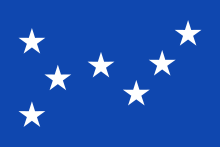Canarian Nationalist Party
| Canarian Nationalist Party | |
|---|---|
| Leader | Juan Manuel García Ramos |
| Founded | 1982 |
| Headquarters | C/. Bernabé Rodríguez 13, Santa Cruz de Tenerife |
| Ideology |
Progressivism, Canarian nationalism |
| Political position | Centre-left |
| Colours | White, blue, yellow and green |
| Election symbol | |
|
| |
| Website | |
| pnc-canarias.eu | |
|
Politics of Spain Political parties Elections | |

The Nationalist Canary Party (PNC) is a nationalist political party in the Canary Islands. Its current headquarters are in Santa Cruz de Tenerife, Tenerife.
Precedents
The first PNC (CNP) was founded in Havana, Cuba on January 30, 1924, by Jose G. Cabrera Díaz, a canarian journalist who became president of the party. He had been a trade union leader of Canary workers. On August 5, 1900, they had founded the Working Canary Association. In the 1920s, Díaz left his working class roots to defend the interests of the middle class. Though the Cuban PNC proclaimed itself as inheritor of Secundino Delgado's thought, the party ideology was far away from the near to anarchism ideas of national and social liberation by Delgado.
The newspaper El Guanche, founded in 1897, was a primary supporter of the party. The party adopted as Canary flag, the "Flag of the Ateneo" (also called "Secundino's Flag"), that is to say, with seven white stars on a blue background arranged to match the position of the country's various islands.
History
In 1982, the newly created PNC held its first congress in the Canary Islands. The party adopted as symbols the 1970s MPAIAC flag, apart from the "Ateneo Flag", as well as some of the Cuban PNC political positions.[1]
In 1993, the party merged with others to form Canarian Coalition (CC), but left the group in 1998. In 2003, after tensions between the militants and the direction, a splinter group formed another "Partido Nacionalista Canario", known as PaNaCa, which accused PNC of betraying its nationalist reivindications. Finally, PaNaCa joined CC.